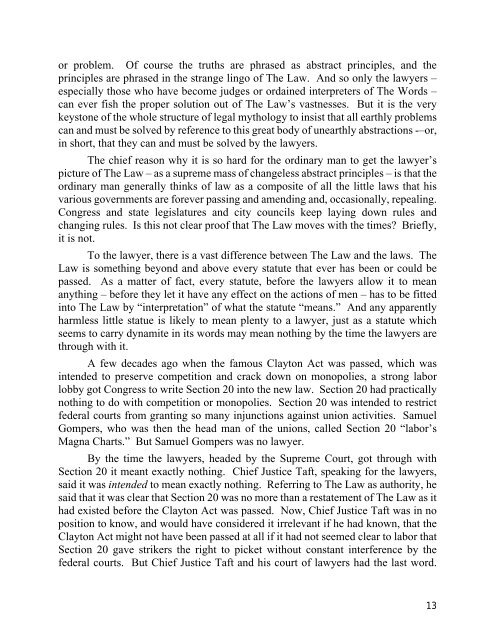WOE UNTO YOU, LAWYERS!
WOE UNTO YOU, LAWYERS!
WOE UNTO YOU, LAWYERS!
You also want an ePaper? Increase the reach of your titles
YUMPU automatically turns print PDFs into web optimized ePapers that Google loves.
or problem. Of course the truths are phrased as abstract principles, and the<br />
principles are phrased in the strange lingo of The Law. And so only the lawyers –<br />
especially those who have become judges or ordained interpreters of The Words –<br />
can ever fish the proper solution out of The Law’s vastnesses. But it is the very<br />
keystone of the whole structure of legal mythology to insist that all earthly problems<br />
can and must be solved by reference to this great body of unearthly abstractions -–or,<br />
in short, that they can and must be solved by the lawyers.<br />
The chief reason why it is so hard for the ordinary man to get the lawyer’s<br />
picture of The Law – as a supreme mass of changeless abstract principles – is that the<br />
ordinary man generally thinks of law as a composite of all the little laws that his<br />
various governments are forever passing and amending and, occasionally, repealing.<br />
Congress and state legislatures and city councils keep laying down rules and<br />
changing rules. Is this not clear proof that The Law moves with the times? Briefly,<br />
it is not.<br />
To the lawyer, there is a vast difference between The Law and the laws. The<br />
Law is something beyond and above every statute that ever has been or could be<br />
passed. As a matter of fact, every statute, before the lawyers allow it to mean<br />
anything – before they let it have any effect on the actions of men – has to be fitted<br />
into The Law by “interpretation” of what the statute “means.” And any apparently<br />
harmless little statue is likely to mean plenty to a lawyer, just as a statute which<br />
seems to carry dynamite in its words may mean nothing by the time the lawyers are<br />
through with it.<br />
A few decades ago when the famous Clayton Act was passed, which was<br />
intended to preserve competition and crack down on monopolies, a strong labor<br />
lobby got Congress to write Section 20 into the new law. Section 20 had practically<br />
nothing to do with competition or monopolies. Section 20 was intended to restrict<br />
federal courts from granting so many injunctions against union activities. Samuel<br />
Gompers, who was then the head man of the unions, called Section 20 “labor’s<br />
Magna Charts.” But Samuel Gompers was no lawyer.<br />
By the time the lawyers, headed by the Supreme Court, got through with<br />
Section 20 it meant exactly nothing. Chief Justice Taft, speaking for the lawyers,<br />
said it was intended to mean exactly nothing. Referring to The Law as authority, he<br />
said that it was clear that Section 20 was no more than a restatement of The Law as it<br />
had existed before the Clayton Act was passed. Now, Chief Justice Taft was in no<br />
position to know, and would have considered it irrelevant if he had known, that the<br />
Clayton Act might not have been passed at all if it had not seemed clear to labor that<br />
Section 20 gave strikers the right to picket without constant interference by the<br />
federal courts. But Chief Justice Taft and his court of lawyers had the last word.<br />
13


